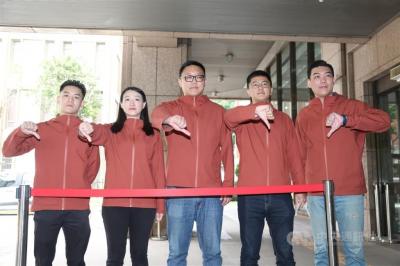The Kaohsiung Main Public Library is the world’s first column-suspended “green” building, library director Pan Cheng-yi (潘政儀) said on Saturday.
The library, which opened in Kaohsiung’s Cianjhen District (前鎮) three years ago, has become a landmark of the city with its innovative energy-saving features, Pan said.
The balconies from the third to eighth floors on the building’s west and south sides have 5m-wide lawns, while an atrium on the sixth floor features a garden with several fully grown trees.

Photo: CNA
The plants help cool the building and reduce the use of air-conditioners, given the city’s high summer temperatures, Pan said, adding that the green surroundings also help visitors refresh themselves.
“The library is a ‘green’ building that can breathe,” Pan said. “There is a garden on its roof, where visitors can view the lovely Port of Kaohsiung.”
There are more than 5,000 air vents on the library’s floors that blow cool air from the bottom up and decrease energy consumption by about 30 percent, he said, adding that the indoor plants can also lower the temperature by 2°C.
Readers, books and the environment are integrated at the library, which is not a rigid structure, but an ecological space in harmony with its surroundings, he said.
The library has set six records, including the world’s first column-suspended building and most transparent library, as well as the world’s largest suspended atrium and the first 7.5m-high square without columns, Pan said.
It is also the nation’s most systematized structure with the most flexible functions, he said.

Taiwan is stepping up plans to create self-sufficient supply chains for combat drones and increase foreign orders from the US to counter China’s numerical superiority, a defense official said on Saturday. Commenting on condition of anonymity, the official said the nation’s armed forces are in agreement with US Admiral Samuel Paparo’s assessment that Taiwan’s military must be prepared to turn the nation’s waters into a “hellscape” for the Chinese People’s Liberation Army (PLA). Paparo, the commander of the US Indo-Pacific Command, reiterated the concept during a Congressional hearing in Washington on Wednesday. He first coined the term in a security conference last

Prosecutors today declined to say who was questioned regarding alleged forgery on petitions to recall Democratic Progressive Party (DPP) legislators, after Chinese-language media earlier reported that members of the Chinese Nationalist Party (KMT) Youth League were brought in for questioning. The Ministry of Justice Investigation Bureau confirmed that two people had been questioned, but did not disclose any further information about the ongoing investigation. KMT Youth League members Lee Hsiao-liang (李孝亮) and Liu Szu-yin (劉思吟) — who are leading the effort to recall DPP caucus chief executive Rosalia Wu (吳思瑤) and Legislator Wu Pei-yi (吳沛憶) — both posted on Facebook saying: “I

The Ministry of Economic Affairs has fined Taobao NT$1.2 million (US$36,912) for advertisements that exceed its approved business scope, requiring the Chinese e-commerce platform to make corrections in the first half of this year or its license may be revoked. Lawmakers have called for stricter enforcement of Chinese e-commerce platforms and measures to prevent China from laundering its goods through Taiwan in response to US President Donald Trump’s heavy tariffs on China. The Legislative Yuan’s Finance Committee met today to discuss policies to prevent China from dumping goods in Taiwan, inviting government agencies to report. Democratic Progressive Party Legislator Kuo Kuo-wen (郭國文) said

Sung Chien-liang (宋建樑), who led efforts to recall Democratic Progressive Party (DPP) Legislator Lee Kun-cheng (李坤城), was released on bail of NT$80,000 today amid outcry over his decision to wear a Nazi armband to questioning the night before. Sung arrived at the New Taipei District Prosecutors’ Office for questioning in a recall petition forgery case last night wearing a red armband bearing a swastika, carrying a copy of Adolf Hitler’s Mein Kampf and giving a Nazi salute. Sung left the building at 1:15am without the armband and covering the book with his coat. Lee said today that this is a serious